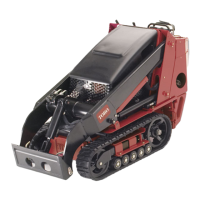23
Securing the Traction Unit for
Transport
Important Do not operate or drive the traction unit on
roadways.
Important When transporting the traction unit on a
trailer, always use the following procedure:
1. Lower the loader arms.
2. Stop the engine.
3. Set the parking brake.
4. Secure the traction unit to the trailer with chains or
straps using the tie-down/lift loops (Fig. 5) to secure
the rear of the traction unit and the loader arms/mount
plate to secure the front of the traction unit.
Lifting the Traction Unit
You can lift the traction unit using the tie-down/lift loops
as lift points (Fig. 5).
Maintenance
Recommended Maintenance Schedule
Maintenance Service
Interval
Maintenance Procedure
8 hours
• Grease the traction unit
• Check engine oil level
• Check for loose fasteners
• Inspect the tracks for damage or wear
25 hours
• Clean the foam pre-filter and the paper air filter
1
• Check hydraulic oil level
6
• Inspect hydraulic lines for leaks
100 hours
• Change engine oil
1,
2
• Check battery electrolyte level
• Replace the paper air filter
1
• Adjust the track tension
• Check battery cable connections
200 hours
• Change engine oil filter (every other oil change)
1,
4
• Change hydraulic filter
1,
3,
5
• Replace the fuel filter
1
• Check spark plugs
400 hours
• Check engine speed (1200 rpm idle and 3600 full throttle, ± 75)
• Inspect fuel lines for leaks
• Change hydraulic oil
1
Yearly/Storage
• Check for loose fasteners
• Touch up chipped paint
• Adjust the track tension
• Check tracks and road wheels
• Charge the battery and disconnect the cables (storage only)
• Drain the gasoline (storage only)
1
More often in dusty, dirty conditions.
2
Change oil after the first 50 operating hours.
3
Change the hydraulic filter after the first 8–10 operating hours
4
For severe duty or rental applications, change every 100 operating hours.

